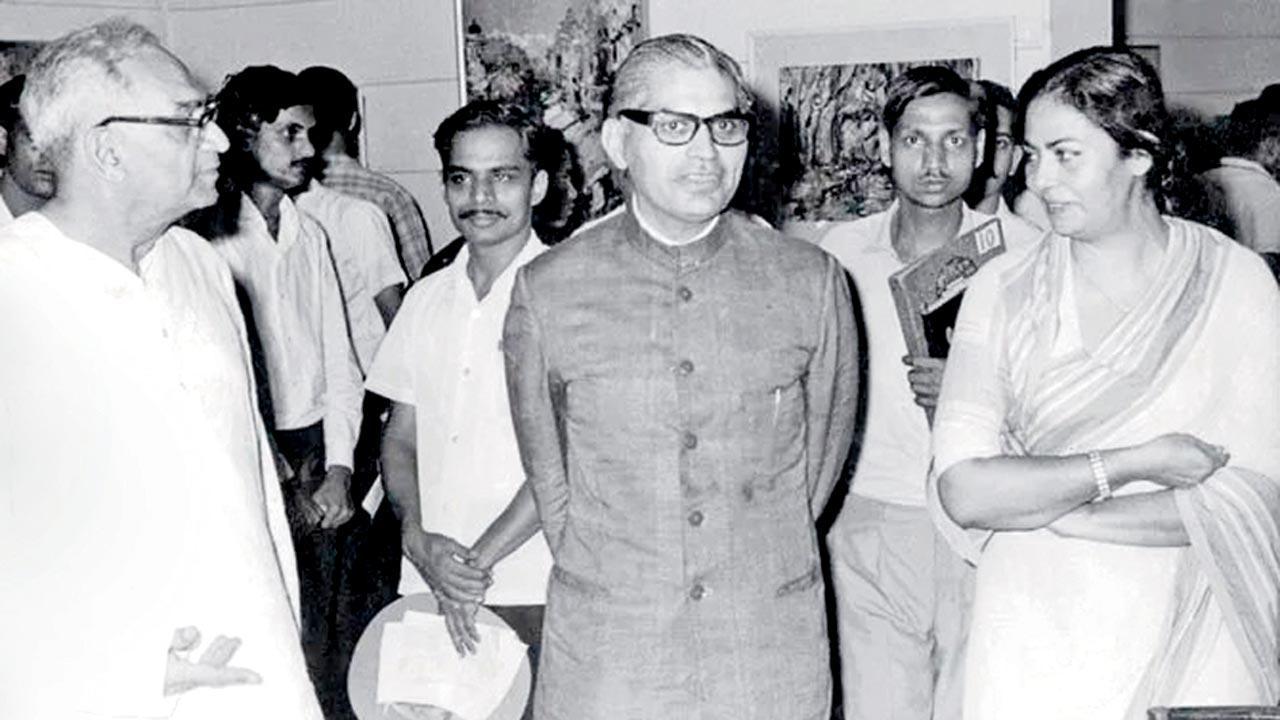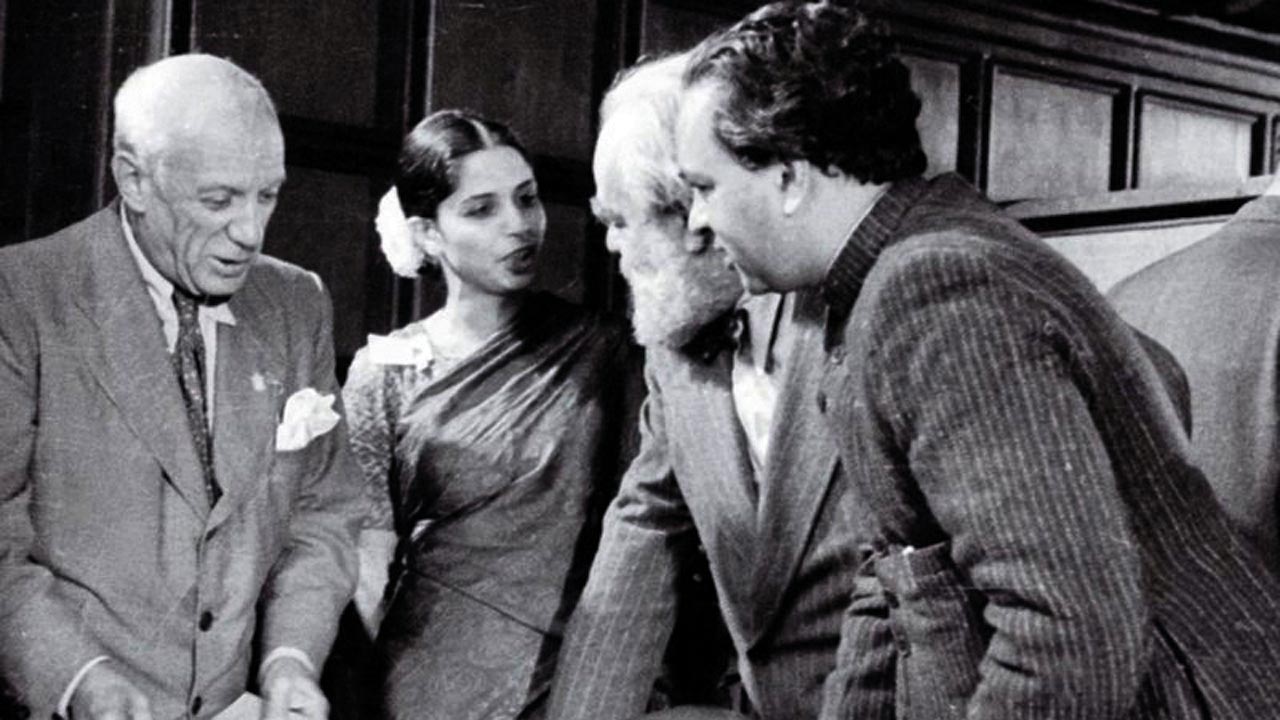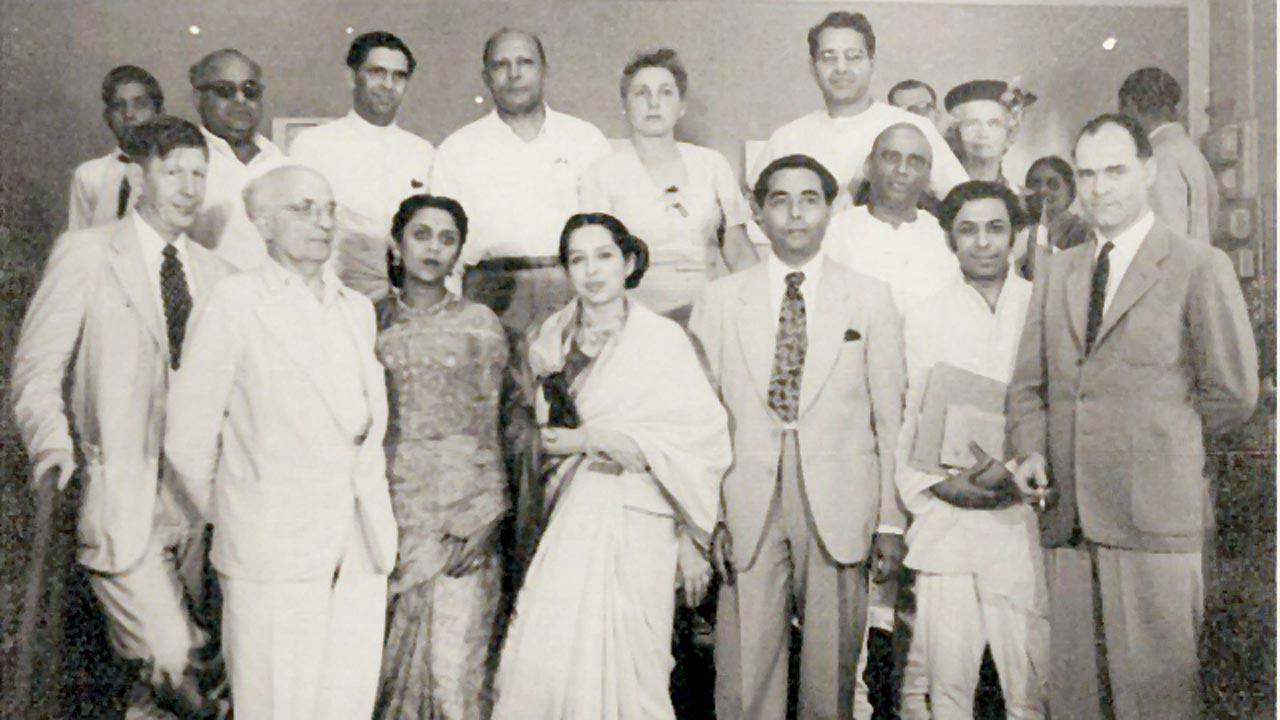Aesthetes with rare vision caught the cultural pulse of 19th and 20th-century Bombay with passion and purpose

Soli Batlivala with Rafique Zakaria and Usha Rajbans Khanna at Samovar cafe, Jehangir Art Gallery. Pic Courtesy/The Making of Samovar, Usha R Khanna
 Seven ads and two rooms were all it took 75 years back. To launch an idea that set the highest standards among art journals internationally. Published from October 1946, the inaugural issue of Marg was wedged between World War II and India’s independence—a critically loaded, focal phase in history.
Seven ads and two rooms were all it took 75 years back. To launch an idea that set the highest standards among art journals internationally. Published from October 1946, the inaugural issue of Marg was wedged between World War II and India’s independence—a critically loaded, focal phase in history.
Struck by the spectacular friezes of the Ajanta caves, litterateur Mulk Raj Anand conceived Marg with 14 other founding members. These included Sri Lankan architect Minnette de Silva, the German chief architect of Mysore State, Otto Konigsberger, collector and art advisor Karl Khandalavala, architects MJP Mistri, JPJ Billimoria and Andrew Boyd, the distinguished first president of the Institute of Town Planners, India, Fayazuddin Sahib, urban expert Percy Johnson-Marshall and art connoisseur Shareef Moloobhoy. Each founder contributed R1,000 and funding was fed by early subscribers.
 Marg co-founders Mulk Raj Anand (extreme right) and Minnette de Silva (centre), with Pablo Picasso (extreme left) and American sculptor Jo Davidson, with early issues of the magazine at the World Congress of Intellectuals in Defence of Peace in Wroclaw, Poland, 1948. Pic/Wikimedia Commons
Marg co-founders Mulk Raj Anand (extreme right) and Minnette de Silva (centre), with Pablo Picasso (extreme left) and American sculptor Jo Davidson, with early issues of the magazine at the World Congress of Intellectuals in Defence of Peace in Wroclaw, Poland, 1948. Pic/Wikimedia Commons
Its initial workspace was granted by JRD Tata, who met Anand through scientist Homi Bhabha. Listening, at a luncheon, to Anand’s eloquent ideals for the publication, JRD asked how he might help. The result? The handful of advertisements and couple of rooms. Anand’s Cuffe Parade apartment was the editorial hub. In 1968, the magazine moved to its current location, the Army and Navy Building.
Marg (Modern Architectural Research Group) was inspired by MARS (Modern Architectural Research Group) of Britain, created in 1933 by modernist practitioners and writers including Francis Yorke, John Betjeman, Maxwell Fry and Wells Coates. Spelt with a parallel serendipity, the name also stands for the word marg meaning “path”—pointing to the way of Indian civilization.
 Delegates of the Congress for Cultural Freedom at Chetana in 1951. First and second from left in the first row are the poet WH Auden and pacifist Salvadore da Madariaga; second and third from right are writers Raja Rao and Sudhakar Dikshit who started Chetana. Pic courtesy/Chhaya Arya
Delegates of the Congress for Cultural Freedom at Chetana in 1951. First and second from left in the first row are the poet WH Auden and pacifist Salvadore da Madariaga; second and third from right are writers Raja Rao and Sudhakar Dikshit who started Chetana. Pic courtesy/Chhaya Arya
Publishing itself was introduced by a stellar family of printers and editors whose six-generation passion for print stays steady with the bilingual Jam-e-Jamshed weekly. Three years after arriving in Bombay from Surat, where he was born into a priestly clan, Fardoonjee Marzbanjee opened a bookbinder’s shop in 1808. Pioneering vernacular journalism, he was responsible for conceiving the printing press in 1812 and the production of Gujarati typefaces.
Fardoonjee most significantly established Asia’s oldest continuing periodical, The Bombay Samachar, on July 1, 1822. A valuable template for subsequent Parsi-helmed papers like the Indian Spectator, eventually Voice of India, the Samachar appeared weekly till 1832, bi-weekly till 1855 and daily since, as Mumbai Samachar.
 Ruins of a cinema, circa 1906, in Wadhwan, the princely state whose Thakore imported the Cinematographe projector for his people’s entertainment after seeing it at the Lumiere Brothers’ screening at Watson’s Esplanade Hotel. Pic/Hemant Chaturvedi
Ruins of a cinema, circa 1906, in Wadhwan, the princely state whose Thakore imported the Cinematographe projector for his people’s entertainment after seeing it at the Lumiere Brothers’ screening at Watson’s Esplanade Hotel. Pic/Hemant Chaturvedi
If Fardoonjee is the acknowledged Father of Gujarati printed literature, his grandson Jehangirjee worked up from proof-reader to partner at 1832-established Jam-e-Jamshed, the “goblet of Shah Jamshid” in which the future was visible.
The ancestral press thrived under Jehangirjee’s proprietorship. Possessed of an easy wit, the humourist hailed as “the Mark Twain of the Parsis”, proved an influential newspaperman. Prior to Jame, he edited the Gujarati magazine Noor-e-Alam, besides managing three leading English dailies: The Times of India, The Advocate of India and The Bombay Gazette.
Those literary genes flourished further to produce a pair of brilliant playwright-editors—Jehangirjee’s son Pirojsha (pen name Pijam) and then his son Adi Marzban.
The Second World War shuffled several plans, casting many on an off-kilter course, yet often signalling wonderful alternatives and initiatives. Sheer chance heralded gallerist-collector Kekoo Gandhy’s foray into art. Though his father hoped he would join the Civil Services, war broke out while Kekoo was in Bombay on vacation from Cambridge, to which he could not return the following term.
Destiny deemed it fit for Gandhy to bump into a Belgian whose father framed and restored Flemish masters. Roger Van Damme astutely assessed that India made the ideal market to sell frames, having heard of the phalanx of images of gods and goddesses revered in Hindu homes. The war caused a shortage of imported supplies of frame mouldings. Van Damme’s acquaintance of Gandhy blossomed to a business proposition. He provided the know-how for the 1940 factory manufacturing chemical mouldings. With finance rustled up by Kekoo and his brother Russy, the venture got christened Gallery Chemould—short for “chemical moulding”.
Art and science fused admirably at a larger institutional level thanks to Dr Bhau Daji Lad, the physician and surgeon also elected the first Indian sheriff of Bombay. Raised with public funds, the structurally magnificent building with high interiors was thrown open on May 2, 1872, in Byculla. Not only did the Victoria and Albert Museum present an unusually embellished Palladian facade, but it was adorned with exterior column capitals of terracotta for the first time in the city. The edifice fronted botanical gardens—naming the spot at which the zoo was, Victoria Gardens—laid in Renaissance Revival style.
The institution was renamed Dr Bhau Daji Lad Museum in 1975, to honour the man whose dedication ensured its inception. The good doctor, credited with discovering Indian drugs as leprosy cures, threw himself wholeheartedly into civic affairs. Among them, he commendably assumed the role of key fundraiser for the Victoria and Albert Museum.
A memorable Bombay evening brought the country an invention which veritably changed the discourse of entertainment and documentation. Photographer and cinematographer Hemant Chaturvedi recently unravelled more about this on his journey filming the last remnants of single-screen theatres across eleven states. Nataraj Talkies, from the 1920s, in the princely walled town of Wadhwan in Saurashtra, has been shut after the 2003 earthquake. Its proprietor Bhawani Singh allowed Chaturvedi to shoot images before driving him around. Halting at a stone wall, they were riveted by the sight of an arched entrance and “booking office” of a nameless open-air cinema, circa 1906.
Apparently, the Thakore of Wadhwan was at Watson’s Esplanade Hotel in Bombay on the July 1896 day when the Lumiere Brothers’ Cinematographe projector debuted. Spellbound by its possibilities, with great foresight he ordered one. By the time a fresh piece was manufactured and shipped from France, it was 1906. What Chaturvedi looked at was the wooden ticket window remnants of the theatre the Thakore built to regale his people with silent movies.
The sagacity of visionary patrons gifted us multi-disciplinary efflorescence. A classic-to-contemporary centre doubling as the city’s earliest art gallery, was Chetana (“awakening”) from 1946. Journalist Sudhakar Dikshit and writer Raja Rao converted this from Sri Vidya Samiti’s Peacock Restaurant and the dance studio where Chetan and Uma Anand held drama classes. Chetana sparked unique creative narratives. Having met the Progressives here, MF Husain declared, “As you had the Bloomsbury Group in England, it’s fair to call us the Chetana Group. Chetana was the nucleus of cultural life not just in Bombay, but all India.”
Chetana mirrored the mood of a citizenry receptive to intellectual rigour. There was a hunger to hear local voices in an emerging young democracy. This was where Damu Jhaveri sold tickets for Indian National Theatre productions. Where MV Kamath happily sat editing copy in lieu of Chetana dosas and coffee. Where customers welcomed a handlooms outlet and thali restaurant added to the centre’s bookshop and chess table.
“My grandfather cultivated confidence in Indian talents showing self-esteem and individuality,” says Kavi Arya. His mother Chhaya, who powered Chetana’s evolution, is Dikshit’s daughter. Kavi’s father was lensman Jitendra Arya.
Another amazing extension of democratic socialism, rallying around the arts as national integration, came to be forerunner to the NCPA. The Bhulabhai Desai Memorial Institute in the 1950s represented the true modern. Under the stewardship of Soli Batlivala, diehard Congressman turned card-carrying communist, the eponymous institute honoured the eminent jurist who bequeathed his wealth to this crucible of culture. Batlivala was personal assistant to Bhulabhai’s son Dhirajlal (Dhiru).
Bombay’s artistic fervour lit up at 89 Warden Road. Madhuriben, Dhirubhai’s archaeologist wife, assigned Batlivala charge as trustee-manager of the unique institute on the estate, comprising two bungalows set at an angle. She lived in the road-fronting bungalow, Hasman, the Dubash residence today. The other ground-plus-one Art Deco structure hummed with vibrant activity. Piloo Pochkhanawala sculpted undisturbed for hours. Husain sketched posters for performances like Medea. Ebrahim Alkazi directed Greek tragedies on the terrace. Gaitonde, Raza, Dashrath Patel and Tyeb Mehta were allotted balcony cubicles or studios for a rupee per day—thinly partitioned, unlocked spaces shared within mutually agreed on timings.
From 1963, Batlivala importantly supervised administration, licensing and bookings at the Jehangir Art Gallery, as honorary secretary. It was his vital decision to lease the first floor to Kekoo Gandhy for Gallery Chemould. He later offered Usha Rajbans Khanna the opportunity to run Samovar Cafe on its iconic little strip.
As dance scholar Sunil Kothari said, “The contribution of Soli Batlivala and the Bhulabhai Institute will go down in the history of Bombay’s art world in golden letters.”
Author-publisher Meher Marfatia writes fortnightly on everything that makes her love Mumbai and adore Bombay. You can reach her at meher.marfatia@mid-day.com/www.meher marfatia.com
 Subscribe today by clicking the link and stay updated with the latest news!" Click here!
Subscribe today by clicking the link and stay updated with the latest news!" Click here!










